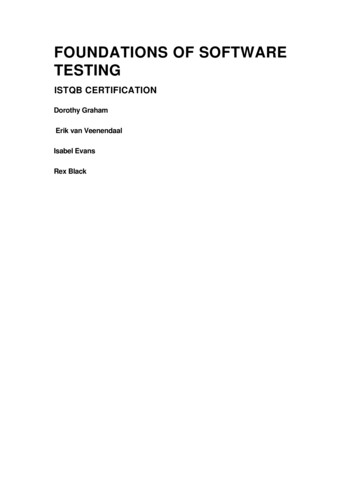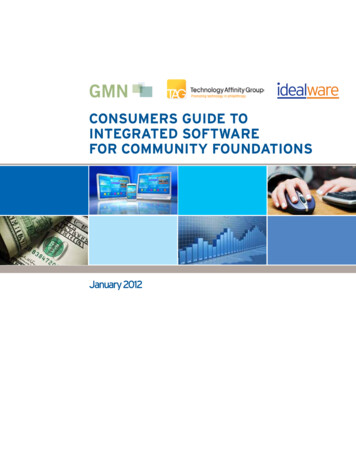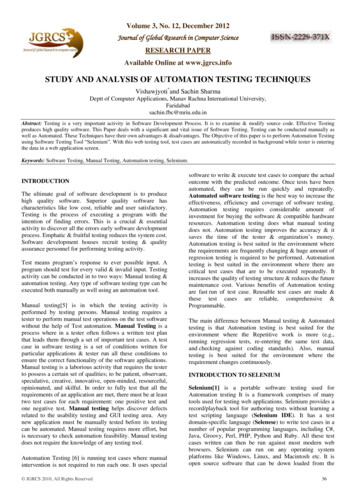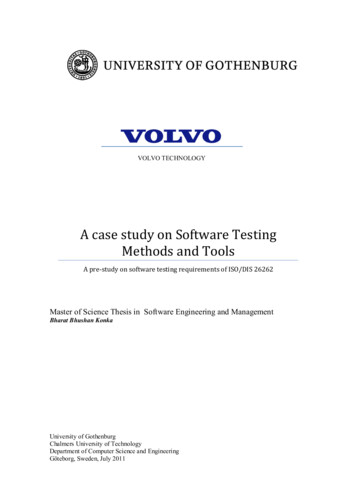
Transcription
FOUNDATIONS OF SOFTWARETESTINGISTQB CERTIFICATIONDorothy GrahamErik van VeenendaalIsabel EvansRex Black
CONTENTSAcknowledgements viii Preface ix1 Fundamentals of testing 11.1 Why is testing necessary? 11.2 What is testing? 111.3 Testing principles 181.4 Fundamental test process 201.5 The psychology of testing 26Chapter review 31Sample exam questions 32Exercise: Test psychology 33Exercise solution 342 Testing throughout the software life cycle 352.1 Software development models 352.2 Test levels 412.3 Test types: the targets of testing 462.4 Maintenance testing 50Chapter review 54Sample exam questions 553 Static techniques 573.1 Reviews and the test process 573.2 Review process 593.3 Static analysis by tools 69Chapter review 74Sample exam questions 754 Test design techniques 774.1 Identifying test conditions and designing test cases 774.2 Categories of test design techniques 844.3 Specification-based or black-box techniques 874.4 Structure-based or white-box techniques 1054.5 Experience-based techniques 1124.6 Choosing a test technique 114Chapter review 117Sample exam questions 118Exercises: Test design techniques 121Exercise solutions 1225 Test management 1275.1 Test organization 1275.2 Test plans, estimates, and strategies 132
5.3 Test progress monitoring and control 1425.4 Configuration management 1485.5 Risk and testing 1495.6 Incident management 155Chapter review 161Sample exam questions 162Exercise: Incident report 165Exercise solution 1666 Tool support for testing 1696.1 Types of test tool 1696.2 Effective use of tools: Potential benefits and risks 1846.3 Introducing a tool into an organization 190Chapter review 193Sample exam questions 1957 ISTQB Foundation Exam 197Preparing for the exam 197Taking the exam 199Mock exam 201Glossary 209Answers to sample exam questions 227References 231Authors 237Companies 239Index 243
CHAPTER 1Fundamentals of testingn this chapter, we will introduce you to the fundamentals of testing: whyIbehindtesting is needed; its limitations, objectives and purpose; the principlestesting; the process that testers follow; and some of the psychologicalfactors that testers must consider in their work. By reading this chapter you'llgain an understanding of the fundamentals of testing and be able to describethose fundamentals.1.1 WHY IS TESTING NECESSARY?1 Describe, with examples, the way in which a defect in software can causeharm to a person, to the environment or to a company. (K2)2 Distinguish between the root cause of a defect and its effects. (K2)3 Give reasons why testing is necessary by giving examples. (K2)4 Describe why testing is part of quality assurance and give examples ofhow testing contributes to higher quality. (K2)5 Recall the terms 'mistake', 'defect', 'fault', 'failure' and the corresponding terms 'error' and 'bug'. (Kl)6 Explain the fundamental principles in testing. (K2)1.1.1 IntroductionIn this section, we're going to kick off the book with a discussion on why testingmatters. We'll describe and illustrate how software defects or bugs can causeproblems for people, the environment or a company. We'll draw important distinctions between defects, their root causes and their effects. We'll explain whytesting is necessary to find these defects, how testing promotes quality, and howtesting fits into quality assurance. In this section, we will also introduce somefundamental principles of testing.As we go through this section, watch for the Syllabus terms bug, defect, error,failure, fault, mistake, quality, risk, software, testing and exhaustive testing.You'll find these terms defined in the glossary.
You may be asking 'what is testing?' and we'll look more closely at the definition of testing in Section 1.2. For the moment, let's adopt a simple everydaylife usage: 'when we are testing something we are checking whether it is OK'.We'll need to refine that when we define software testing later on. Let's start byconsidering why testing is needed. Testing is necessary because we all make mistakes. Some of those mistakes are unimportant, but some of them are expensiveor dangerous. We need to check everything and anything we produce becausethings can always go wrong - humans make mistakes all the time - it is what wedo best!Because we should assume our work contains mistakes, we all need to checkour own work. However, some mistakes come from bad assumptions and blindspots, so we might make the same mistakes when we check our own work as wemade when we did it. So we may not notice the flaws in what we have done.Ideally, we should get someone else to check our work - another person is morelikely to spot the flaws.In this book, we'll explore the implications of these two simple paragraphsagain and again. Does it matter if there are mistakes in what we do? Does itmatter if we don't find some of those flaws? We know that in ordinary life, someof our mistakes do not matter, and some are very important. It is the same withsoftware systems. We need to know whether a particular error is likely to causeproblems. To help us think about this, we need to consider the context withinwhich we use different software systems.1.1.2 Software systems contextTesting Principle - Testing is context dependentTesting is done differently in different contexts. For example, safety-critical software istested differently from an e-commerce site.These days, almost everyone is aware of software systems. We encounter themin our homes, at work, while shopping, and because of mass-communicationsystems. More and more, they are part of our lives. We use software in day-today business applications such as banking and in consumer products such ascars and washing machines. However, most people have had an experience withsoftware that did not work as expected: an error on a bill, a delay when waitingfor a credit card to process and a website that did not load correctly arecommon examples of problems that may happen because of software problems.Not all software systems carry the same level of risk and not all problemshave the same impact when they occur. A risk is something that has not happened yet and it may never happen; it is a potential problem. We are concernedabout these potential problems because, if one of them did happen, we'd feel anegative impact. When we discuss risks, we need to consider how likely it is thatthe problem would occur and the impact if it happens. For example, wheneverwe cross the road, there is some risk that we'll be injured by a car. The likelihood depends on factors such as how much traffic is on the road, whether thereis a safe crossing place, how well we can see, and how fast we can cross. Theimpact depends on how fast the car is going, whether we are wearing protectivegear, our age and our health. The risk for a particular person can be worked outand therefore the best road-crossing strategy.
Some of the problems we encounter when using software are quite trivial,but others can be costly and damaging - with loss of money, time or businessreputation - and even may result in injury or death. For example, suppose auser interface has typographical defects. Does this matter? It may be trivial, butit could have a significant effect, depending on the website and the defect: If my personal family-tree website has my maternal grandmother's maidenname spelt wrong, my mother gets annoyed and I have to put up with somefamily teasing, but I can fix it easily and only the family see it (probably). If the company website has some spelling mistakes in the text, potential customers may be put off the company as it looks unprofessional. If a software program miscalculates pesticide application quantities, theeffect could be very significant: suppose a decimal point is wrongly placed sothat the application rate is 10 times too large. The farmer or gardener usesmore pesticide than needed, which raises his costs, has environmentalimpacts on wildlife and water supplies and has health and safety impact forthe farmer, gardener, family and workforce, livestock and pets. There mayalso be consequent loss of trust in and business for the company and possible legal costs and fines for causing the environmental and health problems.1.1.3 Causes of software defectsWhy is it that software systems sometimes don't work correctly? We know thatpeople make mistakes - we are fallible.If someone makes an error or mistake in using the software, this may leaddirectly to a problem - the software is used incorrectly and so does not behaveas we expected. However, people also design and build the software and theycan make mistakes during the design and build. These mistakes mean that thereare flaws in the software itself. These are called defects or sometimes bugs orfaults. Remember, the software is not just the code; check the definition of software again to remind yourself.When the software code has been built, it is executed and then any defects maycause the system to fail to do what it should do (or do something it shouldn't),causing a failure. Not all defects result in failures; some stay dormant in the codeand we may never notice them.Do our mistakes matter?Let's think about the consequences of mistakes. We agree that any humanbeing, programmers and testers included, can make an error. These errors mayproduce defects in the software code or system, or in a document. If a defect incode is executed, the system may experience a failure. So the mistakes we makematter partly because they have consequences for the products for which we areresponsible.Our mistakes are also important because software systems and projects arecomplicated. Many interim and final products are built during a project, andpeople will almost certainly make mistakes and errors in all the activities of thebuild. Some of these are found and removed by the authors of the work, but itis difficult for people to find their own mistakes while building a product.Defects in software, systems or documents may result in failures, but not all
defects do cause failures. We could argue that if a mistake does not lead to adefect or a defect does not lead to a failure, then it is not of any importance we may not even know we've made an error.Our fallibility is compounded when we lack experience, don't have the rightinformation, misunderstand, or if we are careless, tired or under time pressure.All these factors affect our ability to make sensible decisions - our brains eitherdon't have the information or cannot process it quickly enough.Additionally, we are more likely to make errors when dealing with perplexing technical or business problems, complex business processes, code or infrastructure, changing technologies, or many system interactions. This is becauseour brains can only deal with a reasonable amount of complexity or change when asked to deal with more our brains may not process the information wehave correctly.It is not just defects that give rise to failure. Failures can also be caused byenvironmental conditions as well: for example, a radiation burst, a strong magnetic field, electronic fields, or pollution could cause faults in hardware orfirmware. Those faults might prevent or change the execution of software.Failures may also arise because of human error in interacting with the software,perhaps a wrong input value being entered or an output being misinterpreted.Finally, failures may also be caused by someone deliberately trying to cause afailure in a system - malicious damage.When we think about what might go wrong we have to consider defects andfailures arising from: errors in the specification, design and implementation of the software andsystem; errors in use of the system; environmental conditions; intentional damage; potential consequences of earlier errors, intentional damage, defects andfailures.When do defects arise?In Figure 1.1 we can see how defects may arise in four requirements for aproduct.We can see that requirement 1 is implemented correctly - we understood thecustomer's requirement, designed correctly to meet that requirement, built correctly to meet the design, and so deliver that requirement with the right attributes: functionally, it does what it is supposed to do and it also has the rightnon-functional attributes, so it is fast enough, easy to understand and so on.With the other requirements, errors have been made at different stages.Requirement 2 is fine until the software is coded, when we make some mistakesand introduce defects. Probably, these are easily spotted and corrected duringtesting, because we can see the product does not meet its design specification.The defects introduced in requirement 3 are harder to deal with; we builtexactly what we were told to but unfortunately the designer made some mistakes so there are defects in the design. Unless we check against the requirements definition, we will not spot those defects during testing. When we donotice them they will be hard to fix because design changes will be required.
The defects in requirement 4 were introduced during the definition of therequirements; the product has been designed and built to meet that flawedrequirements definition. If we test the product meets its requirements anddesign, it will pass its tests but may be rejected by the user or customer. Defectsreported by the customer in acceptance test or live use can be very costly.Unfortunately, requirements and design defects are not rare; assessments ofthousands of projects have shown that defects introduced during requirementsand design make up close to half of the total number of defects [Jones].What is the cost of defects?As well as considering the impact of failures arising from defects we have notfound, we need to consider the impact of when we find those defects. The costof finding and fixing defects rises considerably across the life cycle; think of theold English proverb 'a stitch in time saves nine'. This means that if you mend atear in your sleeve now while it is small, it's easy to mend, but if you leave it, itwill get worse and need more stitches to mend it.If we relate the scenarios mentioned previously to Figure 1.2, we see that, ifan error is made and the consequent defect is detected in the requirements atthe specification stage, then it is relatively cheap to find and fix. The observation of increasing defect-removal costs in software traces back to [Boehm].You'll find evidence for the economics of testing and other quality assuranceactivities in [Gilb], [Black 2001] or [Black 2004]. The specification can be corrected and re-issued. Similarly if an error is made and the consequent defectdetected in the design at the design stage then the design can be corrected andre-issued with relatively little expense. The same applies for construction. If
however a defect is introduced in the requirement specification and it is notdetected until acceptance testing or even once the system has been implemented then it will be much more expensive to fix. This is because rework willbe needed in the specification and design before changes can be made in construction; because one defect in the requirements may well propagate intoseveral places in the design and code; and because all the testing work done-tothat point will need to be repeated in order to reach the confidence level in thesoftware that we require.It is quite often the case that defects detected at a very late stage, dependingon how serious they are, are not corrected because the cost of doing so is tooexpensive. Also, if the software is delivered and meets an agreed specification,it sometimes still won't be accepted if the specification was wrong. The projectteam may have delivered exactly what they were asked to deliver, but it is notwhat the users wanted. This can lead to users being unhappy with the systemthat is finally delivered. In some cases, where the defect is too serious, thesystem may have to be de-installed completely.1.1.4 Role of testing in software development, maintenance andoperationsWe have seen that human errors can cause a defect or fault to be introduced atany stage within the software development life cycle and, depending upon theconsequences of the mistake, the results can be trivial or catastrophic. Rigoroustesting is necessary during development and maintenance to identify defects, inorder to reduce failures in the operational environment and increase the qualityof the operational system. This includes looking for places in the user interfacewhere a user might make a mistake in input of data or in the interpretation ofthe output, and looking for potential weak points for intentional and maliciousattack. Executing tests helps us move towards improved quality of product andservice, but that is just one of the verification and validation methods applied toproducts. Processes are also checked, for example by audit. A variety ofmethods may be used to check work, some of which are done by the author ofthe work and some by others to get an independent view.
We may also be required to carry out software testing to meet contractual orlegal requirements, or industry-specific standards. These standards may specifywhat type of techniques we must use, or the percentage of the software codethat must be exercised. It may be a surprise to learn that we don't always test allthe code; that would be too expensive compared with the risk we are trying dealwith. However - as we'd expect - the higher the risk associated with the industry using the software, the more likely it is that a standard for testing will exist.The avionics, motor, medical and pharmaceutical industries all have standardscovering the testing of software. For example, the US Federal AviationAdministration's DO-178B standard [RTCA/DO-178B] has requirements fortest coverage.1.1.5 Testing and qualityTesting helps us to measure the quality of software in terms of the number ofdefects found, the tests run, and the system covered by the tests. We can do thisfor both the functional attributes of the software (for example, printing a reportcorrectly) and for the non-functional software requirements and characteristics(for example, printing a report quickly enough). Non-functional characteristicsare covered in Chapter 2. Testing can give confidence in the quality of the software if it finds few or no defects, provided we are happy that the testing is sufficiently rigorous. Of course, a poor test may uncover few defects and leave uswith a false sense of security. A well-designed test will uncover defects if theyare present and so, if such a test passes, we will rightly be more confident in thesoftware and be able to assert that the overall level of risk of using the systemhas been reduced. When testing does find defects, the quality of the softwaresystem increases when those defects are fixed, provided the fixes are carried outproperly.What is quality?Projects aim to deliver software to specification. For the project to deliverwhat the customer needs requires a correct specification. Additionally, thedelivered system must meet the specification. This is known as validation ('isthis the right specification?') and verification ('is the system correct to specification?'). Of course, as well as wanting the right software system built correctly, the customer wants the project to be within budget and timescale - itshould arrive when they need it and not cost too much.The ISTQB glossary definition covers not just the specified requirements butalso user and customer needs and expectations. It is important that the projectteam, the customers and any other project stakeholders set and agree expectations. We need to understand what the customers understand by quality andwhat their expectations are. What we as software developers and testers maysee as quality - that the software meets its defined specification, is technicallyexcellent and has few bugs in it - may not provide a quality solution for our customers. Furthermore, if our customers find they have spent more money thanthey wanted or that the software doesn't help them carry out their tasks, theywon't be impressed by the technical excellence of the solution. If the customerwants a cheap car for a 'run-about' and has a small budget then an expensive
sports car or a military tank are not quality solutions, however well built theyare.To help you compare different people's expectations, Table 1.1 summarizesand explains quality viewpoints and expectations using 'producing and buyingtomatoes' as an analogy for 'producing and buying software'. You'll see as youlook through the table that the approach to testing would be quite differentdepending on which viewpoint we favor [Trienekens], [Evans].In addition to understanding what quality feels and looks like to customers,users, and other stakeholders, it helps to have some quality attributes tomeasure quality against, particularly to aid the first, product-based, viewpointin the table. These attributes or characteristics can serve as a framework orchecklists for areas to consider coverage. One such set of quality attributes canTABLE 1.1Viewpoints of expectations and qualityViewpointSoftwareTomatoesQuality is measured by looking at theattributes of the product.We will measure the attributes of thesoftware, e.g. its reliability in terms ofmean time between failures (MBTF),and release when they reach aspecified level e.g. MTBF of 12 hours.The tomatoes are the right sizeand shape for packing for thesupermarket. The tomatoeshave a good taste and color,Quality is fitness for use. Quality canhave subjective aspects and not justquantitative aspects.We will ask the users whether theyThe tomatoes are right for ourcan carry out their tasks; if they arerecipe,satisfied that they can we will releasethe software.Quality is based on good manufacturingprocesses, and meeting definedrequirements. It is measured by testing,inspection, and analysis of faults andfailures.We will use a recognized softwaredevelopment process. We will onlyrelease the software if there are fewerthan five outstanding high-prioritydefects once the planned tests arecomplete.Expectation of value for money.We have time-boxed the testing toaffordability, and a value-based trade-off two weeks to stay in the projectbetween time, effort and cost aspects.budget.We can afford to buy this software andwe expect a return on investment.Transcendent feelings - this is about thefeelings of an individual or group ofindividuals towards a product or asupplier.The tomatoes are organicallyfarmed. The tomatoes have noblemishes and no pestdamage,The tomatoes have a goodshelf life. The tomatoes arecheap or good value formoney,We like this software! It is fun and it's We get our tomatoes from athe latest thing! So what if it has asmall local farm and we get onfew problems? We want to use itso well with the growers,anyway.We really enjoy working with thissoftware team. So, there were a fewproblems - they sorted them outreally quickly - we trust them.
be found in the ISO 9126 standard. This hierarchy of characteristics and subcharacteristics of quality is discussed in Chapter 2.What is root cause analysis?When we detect failures, we might try to track them back to their root cause,the real reason that they happened. There are several ways of carrying out rootcause analysis, often involving a group brainstorming ideas and discussing them,so you may see different techniques in different organizations. If you are interested in using root cause analysis in your work, you'll find simple techniquesdescribed in [Evans], [TQMI] and [Robson]. For example, suppose an organization has a problem with printing repeatedly failing. Some IT maintenancefolk get together to examine the problem and they start by brainstorming all thepossible causes of the failures. Then they group them into categories they havechosen, and see if there are common underlying or root causes. Some of theobvious causes they discover might be: Printer runs out of supplies (ink or paper). Printer driver software fails. Printer room is too hot for the printer and it seizes up.These are the immediate causes. If we look at one of them - 'Printer runs outof supplies (ink or paper)' - it may happen because: No-one is responsible for checking the paper and ink levels in the printer;possible root cause: no process for checking printer ink/paper levels beforeuse. Some staff don't know how to change the ink cartridges; possible root cause:staff not trained or given instructions in looking after the printers. There is no supply of replacement cartridges or paper; possible root cause:no process for stock control and ordering.If your testing is confined to software, you might look at these and say,'These are not software problems, so they don't concern us!' So, as softwaretesters we might confine ourselves to reporting the printer driver failure.However, our remit as testers may be beyond the software; we might have aremit to look at a whole system including hardware and firmware. Additionally,even if our remit is software, we might want to consider how software mighthelp people prevent or resolve problems; we may look beyond this view. Thesoftware could provide a user interface which helps the user anticipate whenpaper or ink is getting low. It could provide simple step-by-step instructions tohelp the users change the cartridges or replenish paper. It could provide a hightemperature warning so that the environment can be managed. As testers, wewant not just to think and report on defects but, with the rest of the projectteam, think about any potential causes of failures.We use testing to help us find faults and (potential) failures during softwaredevelopment, maintenance and operations. We do this to help reduce the riskof failures occurring in an operational environment - in other words once thesystem is being used - and to contribute to the quality of the software system.However, whilst we need to think about and report on a wide variety of defectsand failures, not all get fixed. Programmers and others may correct defects
before we release the system for operational use, but it may be more sensible towork around the failure. Fixing a defect has some chance of introducinganother defect or of being done incorrectly or incompletely. This is especiallytrue if we are fixing a defect under pressure. For this reason, projects will takea view sometimes that they will defer fixing a fault. This does not mean that thetester who has found the problems has wasted time. It is useful to know thatthere is a problem and we can help the system users work around and avoid it.The more rigorous our testing, the more defects we'll find. But you'll see inChapters 3 and 4, when we look at techniques for testing, that rigorous testingdoes not necessarily mean more testing; what we want to do is testing that findsdefects - a small number of well-placed, targeted tests may be more rigorousthan a large number of badly focused tests.We saw earlier that one strategy for dealing with errors, faults and failures isto try to prevent them, and we looked at identifying the causes of defects andfailures. When we start a new project, it is worth learning from the problemsencountered in previous projects or in the production software. Understandingthe root causes of defects is an important aspect of quality assurance activities,and testing contributes by helping us to identify defects as early as possiblebefore the software is in use. As testers, we are also interested in looking atdefects found in other projects, so that we can improve our processes. Processimprovements should prevent those defects recurring and, as a consequence,improve the quality of future systems. Organizations should consider testing aspart of a larger quality assurance strategy, which includes other activities (e.g.,development standards, training and root cause analysis).1.1.6 How much testing is enough?Testing Principle - Exhaustive testing is impossibleTesting everything (all combinations of inputs and preconditions) is not feasible except fortrivial cases. Instead of exhaustive testing, we use risks and priorities to focus testing efforts.We've seen that testing helps us find defects and improve software quality. Howmuch testing should we do? We have a choice: test everything, test nothing ortest some of the software. Now, your immediate response to that may well be tosay, 'Everything must be tested'. We don't want to use software that has notbeen completely tested, do we? This implies that we must exercise every aspectof a software system during testing. What we need to consider is whether wemust, or even can, test completely.Let's look at how much testing we'd need to do to be able to test exhaustively. How many tests would you need to do to completely test a one-digitnumeric field? The immediate question is, 'What you mean by test completely?'There are 10 possible valid numeric values but as well as the valid values weneed to ensure that all the invalid values are rejected. There are 26 uppercasealpha characters, 26 lower case, at least 6 special and punctuation characters aswell as a blank value. So there would be at least 68 tests for this example of aone-digit field.This problem just gets worse as we look at more realistic examples. In practice, systems have more than one input field with the fields being of varyingsizes. These tests would be alongside others such as running the tests in differ-
Section 2ent environments. If we take an example where one screen has 15 input fields,each having 5 possible values, then to test all of the valid input value combinations you would need 30 517 578 125 (515) tests! It is unlikely that the projecttimescales would allow for this number of tests.Testing our one-digit field with values 2, 3 and 4 makes our tests more thorough, but it does not give us more information than if we had just tested with thevalue 3.Pressures on a project include time and budget as well as pres
7 ISTQB Foundation Exam 197 Preparing for the exam 197 Taking the exam 199 Mock exam 201 Glossary 209 Answers to sample exam questions 227 References 231 . In this section, we're going to kick off the book with a discussion on why testing matters. We'll describe and illustrate how softwa










